
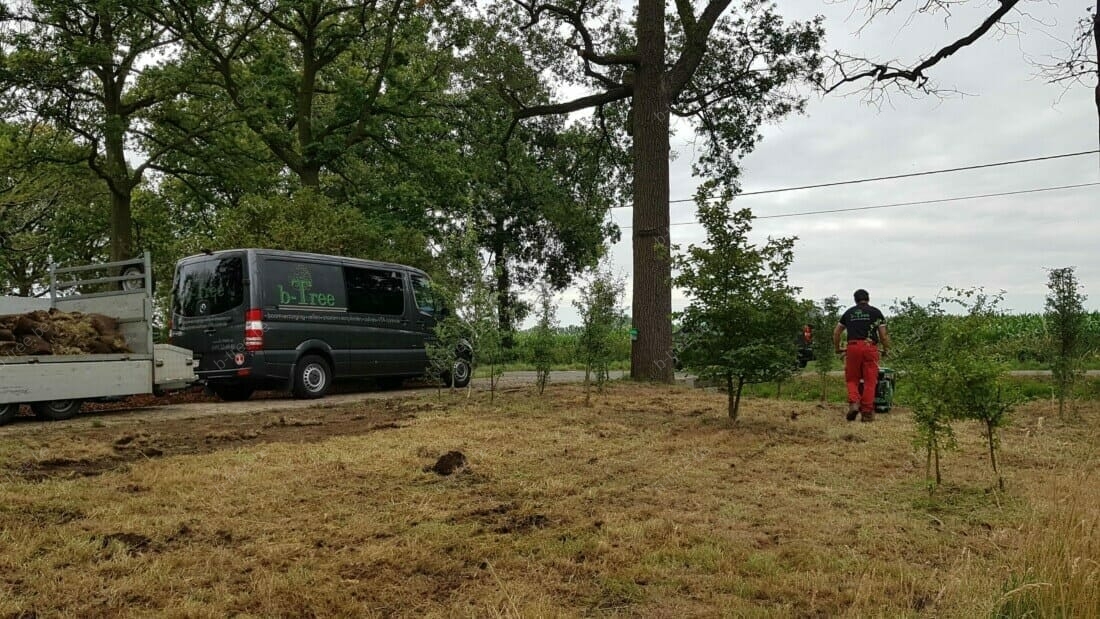
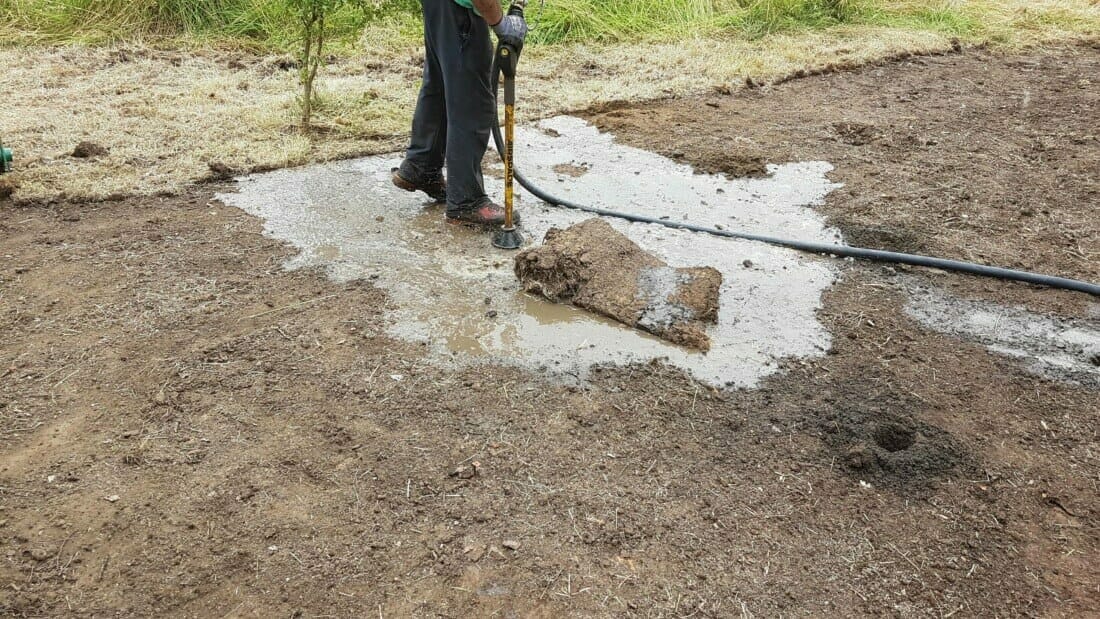
Growing place improvement for trees
By improving the growing area you give your tree a better condition again. And you improve and revitalize the health of your tree. This increases life chances.
A healthy tree can also defend itself better against attackers such as insects and parasitic fungi. And can tolerate pruning better. If the latter proves necessary.
In the last photo above, you can see the popping of the soil around trees as part of the habitat improvement. This ensures that the soil is well aerated and aerated.
This in turn greatly benefits the soil life and the root growth of the tree.
The water you see escaping in this photo is trapped water (rarely occurs) that caused rotting of the roots in an anaerobic soil layer.
By aerating the soil, on the one hand, the "rotten" water can escape (flow out) and on the other hand, oxygen can return to the soil.
What is a growing area improvement?
A growth site improvement is improving the quality of the soil in which the tree is rooted. This restarts soil life and gives the tree more nutrients, water and oxygen. So that the tree species' own ecosystem gets going again.
Sometimes it may also be necessary to increase the rootable soil volume. So that the tree can further develop into its natural final image.
You can read more about how you can improve the quality of the soil on this page.
Why is a growing area improvement sometimes necessary?
A growth site improvement is sometimes necessary to prevent a tree from prematurely entering its final phase and dying. By improving the growing area you ensure that the tree gets out of its stressful situation and becomes vital again.
A tree can weaken, temporarily or long-term. And this is visible. Because of the weakening, the life expectancy of the tree also decreases. A growing area improvement is then often necessary. To postpone the final phase of the tree as long as possible. Or save it from dying.
On the other hand, it is pruning of a weakened tree is evil.
This will weaken it even more.
So pruning away dead branches on the outside of the crown, to make the tree look better again, so to speak, is disastrous in this case. Because trees in poor condition, which are under stress, cannot tolerate pruning.
A growth site improvement is the only correct solution and the only resort here.
Because the tree itself has already had branches die because there is something wrong in the soil. And by putting the tree's growing place back in order, the tree regains its strength.
Later, when it is clear that the tree has regained its strength, only then can you consider pruning the tree.
Removing dead wood from the outside of the crown is possible on a weakened tree, as long as you simply break off the wood, but do not make pruning wounds.
What is the location of a tree?
The location of a tree is the geographical location where the tree is located. This could be a forest or a flower bed. Or a verge along the street or sidewalk. Also be a dike or a meadow.
The term location says nothing about the qualitative properties of the soil in which the tree grows.
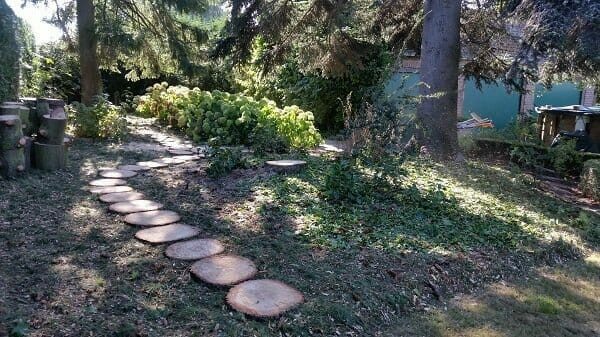
Growth site improvement of a Scots pine (Pinus silvestris) in Brussels. The wood from a felled fir tree from the same garden was used for soil improvement. Discs were then sawn from the trunk. And used as an ecological walking path. As a result, the footsteps of walkers are less damaging to the growing area of the Scots pine. The latter can also be part of a growing area improvement.
What is the difference between location and growth location of a tree?
This brings us to the term 'growth place'. This refers to the qualitative properties of the location.
A suitable growing place for a tree is a place that is neither too wet nor too dry. That has sufficient space for the roots to penetrate. Which contains the right nutrients (minerals, trace elements). And allows sufficient oxygen to pass through.
And it has many other soil properties that are tailored to the well-being of a healthy tree.
A good growing location offers development opportunities for a tree. So that the tree can grow into a future tree.
In general, in Belgium, only the term location is often used. This also refers to the qualitative properties of the place where the tree is located. So the growing place.
By site improvement we actually mean growth site improvement. In Belgium people sometimes still talk about site improvements. In the Netherlands, however, people always talk about growing area improvement.
Why is the growing location of a tree so important?
The growing location of a tree ensures that the tree can carry out all its physiological processes in a normal and healthy way. Such as absorbing water and nutrients, converting carbon dioxide into sugars and storing it, absorbing and producing oxygen and growing.
The place where a tree grows is therefore extremely important for its well-being.
Both for his health, fitness and vitality.
That is why growth site improvement is very useful for weakened trees. Or these in poor condition.
A healthy tree can only be achieved by taking care of its growing area.
If there are problems with the growing area, this will quickly become apparent from the loss of condition. This will make the tree easier to fall prey to diseases and infestations.
It is similar to our human body. If we drink too little water, don't sleep enough, eat poor nutrition, or don't exercise enough, we are more likely to get sick.
An improvement in the growing area therefore gives a boost to the condition of the tree.
What factors disrupt the growing location of a tree?
All the factors that cause the soil in which the tree is rooted to become unsuitable for the tree to maintain its physiological processes are disruptive factors. These factors are:
- soil compaction,
- lack of oxygen in the soil,
- rewetting,
- salinization of the soil,
- abnormal pH or acidity of the soil,
- drought stress,
- lack of nutrients,
- insufficient root space,
- pathogens present in the soil,
- too little organic material present in and on the soil,
- groundwater table disturbs or changes.
What is the condition of a tree?
The condition of a tree is the status of its current state of health. It tells you what his current health is like. And how well a tree's life processes perform. The quality of the crown development, with or without larger problem branches, is also part of the condition.
The condition can range from very good to very bad and even dying or dead.
Trees in good condition function well, look radiant, and have an abundant crown of leaves. All life processes then work as they should and the tree grows diligently. The leaf color is deep green, of course depending on the species, and there are leaves on the end of each twig. Or in other words, not a single twig on the outside of the crown is missing a leaf. Because there is light and a healthy tree in good condition, put as many of its leaves there. And this makes the tree function best. He can then handle the maximum photosynthesis do and build up sugars. Which it needs to build up its entire structure, such as leaves, sapwood, bark, branches, twigs, fruits, ... and so on.
Easily recognizable thickness growth and active wound overgrowth are also among the characteristics of good condition.
If a copy is in poor condition, you will notice deviations here. We call this loss of condition.
How do you recognize loss of condition in trees?
Loss of condition in trees can be recognized by various characteristics of a tree:
- no normal leaf formation. Fewer leaves than normal. You can easily see the blue sky through the canopy.
- smaller leaves than normal.
- partially dried leaves.
- faster leaf loss than normal.
- no leaf loss in autumn.
- branches that are in the light and yet have no leaves at the end.
- leaf color is less deep green or different.
- branch mortality and top mortality.
- pruning wounds or wounds from natural branch cleaning that do not or hardly grow over.
- rot, fruiting bodies of fungi on the trunk, cracks, torsion cracks, cavities, etc.
- not normally developed crown, with large problem branches.
- no or very moderate thickness growth
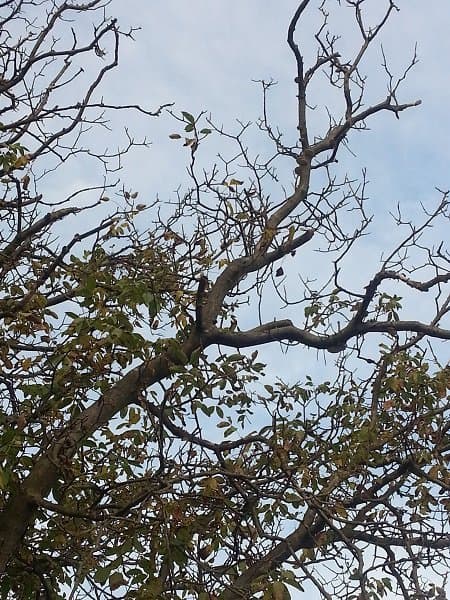
A growth site improvement is very useful for trees with branch death (as in this photo). Branch death is often the result of compacted soil. A soil with a lack of oxygen or poor water management.
Do you have doubts about the poor condition of your tree? Or do you have doubts or questions about whether or not a healthy tree? Then ask us advice by our Certified Tree Manager and leave your tree in time inspect. In addition to the possibly poor condition, other issues may come to light.
This way, a decision can be made on a sound basis as to whether a growing area improvement may be necessary. Or that, in the worst case, we will have your need to fell or cut down a tree if the situation is irreversible. Especially if it would pose a danger to the environment.
What is the difference between condition and vitality of a tree?
The difference between condition and vitality of a tree is that condition tells you what the current condition and health of a tree is. And the vitality shows how a tree can or cannot still respond to stress factors, such as heavy branch breakage, deteriorated growing conditions or drought and wetting.
A tree may be in poor condition, but have good vitality
There are quite a few misunderstandings between the concepts of condition and vitality when it comes to trees.
The condition says something about the tree and its current condition. We explained this above.
The vitality indicates the ability to respond to stress factors that the tree is confronted with and how it deals with them. Trees in poor condition are under stress. And not all trees that are under stress can cope with this.
An example of the difference between fitness and vitality makes this clearer.
When a tree is confronted with storm damage and a very large branch breaks out, the tree is suddenly stressed. A whole part of its leaves or energy factories are gone. If the tree then responds with a lot waterlot These are small groups of leaves that grow directly on (large) branches and the trunk, it quickly compensates for leaf loss. So the tree responds and then we talk about good vitality. If it doesn't respond at all, and none waterlot puts, the tree has a bad one resilience and vitality and there is a good chance that it will die off in the long term.
You can improve the condition by, for example, improving the growing area, but the tree must have the ability, or be vital enough, to do something with its improved soil.
As a layman, it is not always easy to judge the correct condition and vitality of a tree. However, a experienced and professional tree care professional and certainly ours Tree Manager can help you with this.
What are the most common disruptive factors for a tree's growing location?
The growing place of trees in a forest, where no people come and where no extreme weather conditions influence it, will not be disturbed. And forms a suitable soil for growing and developing trees. Every year the leaves fall, decompose and thus help create an ideal humus layer and soil.
Disturbed growing areas also occur in built-up and human-used environments.
The most common disruptive factors for a growing site are:
- soil compaction and lack of oxygen due to traffic,
- too small space for root penetration or too low available soil volume when laying paving,
- location that is too wet or too dry or changes in water management,
- changing the groundwater level, for example by switching on and off groundwater drainage or by excavation work,
- poor soil quality, due to, for example, eutrophication or road salt loading. Or poor fertility,
- earth and excavation work resulting in mechanical root damage,
- raising of the ground level or terrain, resulting in a lack of oxygen,
- competition from other crops or plants, such as grass under and around the tree or in the tree mirror,
- a combination of the above factors.

A growth site improvement is necessary for trees that exhibit a lack of oxygen. In the photo you can see a lack of oxygen in a severely deteriorated birch. The lack of oxygen can be seen by the dark (blue) discoloration in the sections of the saw cuts.
How to investigate growing areas to identify soil problems?
To identify the disturbing factors in the soil, it is crucial that we investigate the growth location of the tree.
We do this, among other things:
- By digging a test trench for root research and to determine the groundwater profile.
- Examine the tree roots. Is there a lack of oxygen? Or have tree roots died?
- By measuring the oxygen content in the soil.
- Measure the penetration resistance with a penetrometer.
- Do a soil analysis to determine the chemical composition. And possibly also to map soil life.
- ...
It is necessary to take action at the first signs of loss of condition. When a disruptive factor is found, a growing area improvement is often indicated.
Due to a severe lack of oxygen, a tree can die in just a few days.
By providing the tree with a quality growing place, it will regain its strength and become healthier. Condition and vitality will increase again. This allows the tree infections and pathogens then better defense and braking.
This will increase life expectancy. Especially if you do not carry out any growth site improvement.
A healthy tree can only remain healthy if the growing area is in excellent condition. If the root system can live optimally, we will see a very beautiful crown as a thank you from the tree. Above ground then.
The soil and growing place is the start of everything.
Feel free to make one Appointment with us for one tree advice.
How do you improve the condition of a tree?
When improving a growing area, you first conduct research into the reason for the declining condition of your tree or trees. This research will provide you with information about all disturbing elements present at the location and growing location.
This also includes a soil investigation, such as digging a profile pit, and a root investigation.
The soil profile tells a lot about any disturbing layers in the soil. And where and how the tree can absorb water during the different seasons.
The root examination shows whether sufficient root development is possible and, for example, there is no lack of oxygen. Because in the absence of oxygen, roots die quickly.
After the examinations, you determine what measures need to be taken to improve the growing area and make your tree shine again with health.
Possible measures are:
- popping from the bottom,
- applying a litter layer,
- installation of natural air ducts,
- applying elaborated organic material,
- applying chopped wood layer,
- watering the soil.
More drastic measures for growing area improvement
You can carry out a site improvement in different ways. Depending on the severity of the soil quality and soil conditions, you will combine one or more solutions to finally solve the problem. As described above. But it may be necessary to take more drastic measures:
- land exchange,
- breaking the soil with ripper tooth, without causing root damage,
- installing drainage,
- increase root space,
- increase tree level and apply compost layer and chopped wood layer,
- installing irrigation system,
- installing food chutes,
- or a combination of the above.
This always entails minor civil works, which must absolutely not lead to root damage.
Carrying out a successful growth site improvement is therefore specialist work that is best left to us. You have to take too many factors into account for a successful result.
A successful growth site improvement will be reflected in the increasing condition of your tree year after year. A richer leaf setting. No more dead wood on the outside of the crown. And a deep green leaf color of the leaves.
Do you have questions? Don't hesitate and let us know.
We are happy to answer them and can always do so expert tree advice Offer.
Why is compost and wood chippings good as a growth site improvement?
A tree mirror with a compost layer containing chopped wood offers many benefits for the tree.
The compost layer is already partially or completely decomposed organic material. With a low nitrogen content. Due to the slow breakdown (digestion), the tree receives its nutrition drop by drop every day. And not with a boost as is the case with a fertilizer. And a compost layer and afterwards also the wood chippings layer itself, because this also starts to decompose, provide daily drop by drop nutrition for many years.
The wood chippings are undecomposed organic material. It provides a second layer on top of the compost layer. And it has multiple functions.
For example, the chopped wood layer will serve as insulation in very dry and hot summer weather. This prevents water from evaporating from the soil (compost layer and deeper). So that the tree has water available. And also in dry weather.
During a very wet period, the chopped wood layer will partially buffer the rainwater. And because the soil under the wood chippings is always moist and earthworms live there, the tunnels that the earthworms dig will also drain the water better. And get it deeper into the ground faster, which is an advantage after a long dry period. The water then reaches the roots faster.
Fungi in the tree trunk as a result of a chipped wood layer

After carrying out a growth site improvement, fruiting bodies of fungi often appear in the tree surface of the tree. Which is of course very desirable. Here you see fly agarics as ectomycorrhiza-forming symbionts near a birch. The “good” fungi that are ideal for the location of the tree.
The wood chippings layer also harbors fungi (saprophytes and symbionts). They break down the chopped wood very slowly and convert it into absorbable nutrients for the tree. The symbionts (for our native trees ectomycorrhizal symbionts) provide the trees with natural antibiotics and natural fungicides. These protect the trees against respective bacteria and parasitic fungi. The symbionts will get sugars from the tree. Because they have no chlorophyll themselves and cannot produce sugars, this is where the symbiosis lies.
This growth site improvement ensures a high-quality long-term location for the tree, if the other disturbing factors are also removed.
Can every tree be saved with a growth site improvement?
To our regret, this is unfortunately not the case.
When a specimen is affected by the real honey fungus, gloomy honey fungus, real tinder fungus, an sulfur fungus or another aggressive parasite, a habitat improvement will no longer be able to save the tree. The stretching of the lifespan depends on the stage of the attack, the location and the tree species, sometimes still possible.

Here you see sulfur fungus on a Prunus serotina (bird cherry). With some aggressive parasitic fungal infestations, growth site improvement is often no longer appropriate.
Here it must be considered whether the investment in a growing area improvement is worthwhile or not. This will depend on how many years the tree can offer more resistance due to the growth site improvement. And what this means in years of extra life expectancy for the tree.
The mycological knowledge of arborists Bert Janssens can help you a lot further. Necessary for correctly assessing the situation. And for correct tree advice.
Growth site improvement is a very powerful way to help a tree get back on track. But if the situation is too bad, improving growing areas will no longer help. So let us take a thorough look advice indicate whether a growth site improvement is useful for your tree.
Price of a growing area improvement. Ask us without obligation.
Every tree location is different. Both in type and size. That's why we kindly ask you can be contacted without obligation.
The price can vary between €300 for a small growth site improvement and €2.500 or more for a large growth site improvement. Everything also depends on size, accessibility and soil conditions.
We are happy to visit you without obligation to offer our best solution and price.
Photos of successful growing area improvements
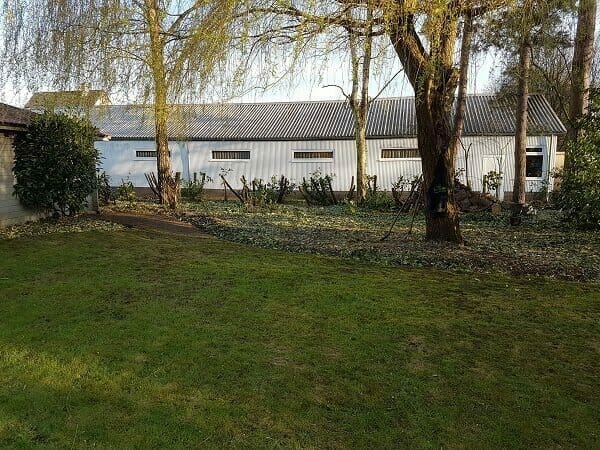
Growth site improvement of a weeping willow (Salix babylonica or Salix pendula) in Hulshout. Here all the prunings were chopped from the hedges and shrubs. The chopped wood was then used as a soil improver. Both for the border at the back of the garden and around the weeping willow.
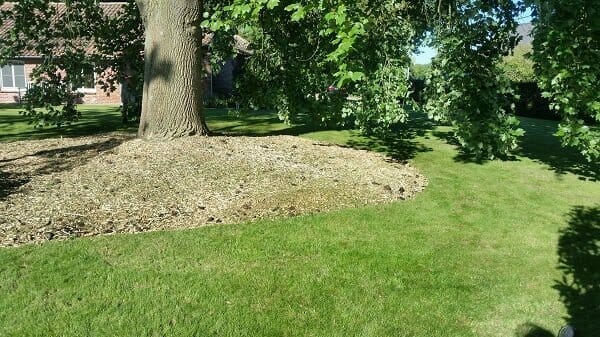
During this habitat improvement of a Liriodendron tulipifera in Lier, the grass under the crown projection of the tree was removed. Afterwards, fully developed compost was fed under the crown projection (in the tree mirror). And this layer is covered with chopped wood. An ideal combination. To provide the tree with useful nutrients. Without adding too much nitrogen. A year later, several fruiting bodies of endomycorrhizal symbionts were found. Ideal for the location of the tree.
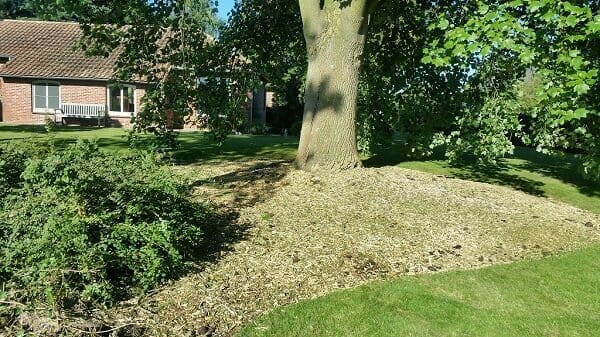
Second photo of the improvement of the growth location of the tulip tree in Lier.
Feel free to ask without obligation your question. We are happy to answer them.